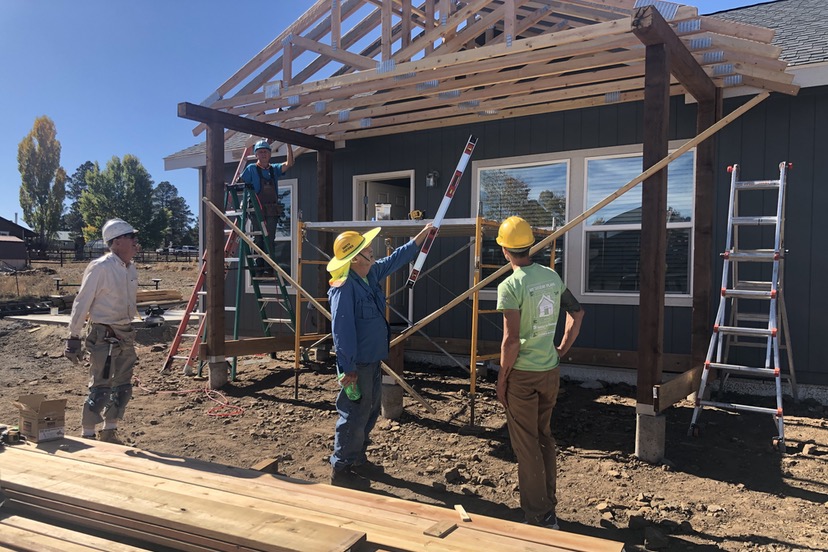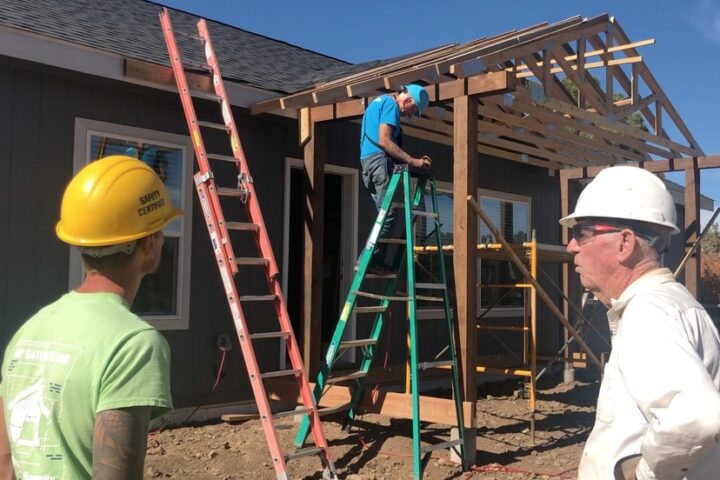PHOTO: The construction crew working on a Habitat for Humanity home on Ranger Park Drive, in the Trails subdivision. October 2023.
As was mentioned yesterday in Part Three, I suggested to the Archuleta Board of County Commissioners during public testimony at their regular meeting this week that we’re all trying to do our best for our community.
We can’t agree what “best” means.
My personal preference for a community is admittedly old fashioned. It’s similar to the kind of community Clarissa and I found when we moved to Pagosa in 1993. A tourism industry existed back then, but it didn’t overshadow the entire economy. A vibrant (if occasionally amateurish) construction industry existed. Many people worked in retail; many people worked for government and schools; many people worked in food service; the Fire Protection District had a sufficient number of volunteers.
We didn’t have a hospital, back then, but we had an ambulance service to take people to Durango. I’m sure a majority of our community is pleased that we now have a much more robust health care industry in Archuleta County — Pagosa Springs Medical Center, Pagosa Medical Group, Axis Health, and soon, an Archuleta County Public Health Department.
Many Pagosans were self-employed in 1993… and that pattern has continued, with the additional employment opportunities to work for big corporations, remotely.
These working folks could afford housing here. Back then.
Based on the numbers I am hearing latest from community leaders, a traditional single family home of the type Americans typically imagine themselves owning at some point — that is to say, the type of single family homes so many of us were able to afford two or three decades ago — now costs in excess of $400,000 to build. According to Zillow.com, a family now needs an annual income of about $120,000 in order to afford a new home costing $400,000.
I was chatting with a friend yesterday, who works in the food industry. He and his wife are taking a less traditional route to their own home. They are planning to purchase a rather small ‘kit’ home that can — if you believe the marketing pitch — be built in less than a week. The ‘kit’ costs less than $40,000. They already own a vacant lot in Aspen Springs subdivision, with no running water, no central sewer, no electricity. But there are solutions. A $30,000 septic system. A cistern for storing hauled water. A modest system for solar electricity. A propane tank. A wood stove.
After paying to build the driveway, and the foundation for the kit home, and the building permits, and on-site utilities, the cost of the home might be $150,000.
With bank mortgage rates now at 7%, it’s also helps when you can get a loan from your parents.
With luck, and with wealthy parents, a young working couple can still afford to build a small home in Aspen Springs. If they don’t mind hauling their water, and having a limited amount of electricity. And chopping wood for heat.
If you’re lucky, you might even have internet service.
As we chatted about whether Pagosa’s population might grow, over the next 25 years, I mentioned the predictions developed by the Growing Water Smart study group in 2019. I shared a graph earlier this week, in Part Two, illustrating a range of possible outcomes based on past history… a high estimate of about 24,000 full-time residents in 2050… and a low estimate of 18,000 full-time residents.
A growth — from our current population of maybe 14,000 — of between 4,000 and 10,000 new residents.
My friend wondered where in the community those new residents might build their homes, or where new apartment buildings might be located.
He noted that Aspen Springs seems to have plenty of vacant parcels, still undeveloped since the subdivision was created in 1969.
Aspen Springs could grow, he thought. Especially, if it were connected to running water, someday. And if your vision of the American Dream is modest, you can still build a home there for under $200,000. Assuming, perhaps, that you can get a loan from your parents.
By my estimate, there are at least 5,000 vacant parcels within the 21-square miles of the Pagosa Lakes subdivisions, almost all served by running water and electricity. But these subdivisions are also cursed with CC&Rs — covenants, conditions, and restrictions — dating from the 1970s, that basically prohibit the construction of a simple, cozy home of the type my friend wants to build in Aspen Springs. As I’ve discussed in this editorial series, a new “affordable” home in any of the PLPOA subdivisions will likely cost $400,000 to build in our current economy.
Within the entire 21-square miles, there are very few places where you’re allowed to build an apartment building.
I stopped by one of the three Habitat for Humanity homes being completed this fall… the one on Ranger Park Drive in the Pagosa Trails subdivision. Thanks to USDA subsidies, and volunteer labor, and donated materials, and sweat equity from the buyers, and fee waivers from local governments, and help from a national housing organization… Habitat Archuleta is able to sell these homes, relatively affordably, to working families.
In the case of the home on Ranger Park Drive, our local electricity cooperative, La Plata Electric Association (LPEA), stepped up with some financial assistance, as part of an experimental housing program.
If this same home were built by a private developer and financed with a conventional loan, it would likely cost in excess of $400,000, I was told.
But Pagosa needs a lot more than three affordable homes to be built each year. And they probably won’t be located within the 21-square miles of PLPOA.
As mentioned before, the Root Policy Research study from 2021 estimated the shortage of workforce housing, in Archuleta County, at about 800 units.
We can do it. If we put our minds to it… and if we want to do it.
But if our leaders are just fine with our community going the way of Vail, and Aspen, and Breckenridge, and Telluride — towns where, practically speaking, only millionaires can afford to live — I will be sorely disappointed.


